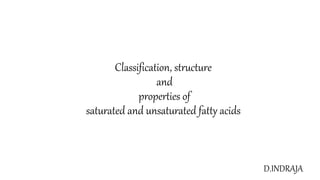
Fattyacids classification, structure and properties
- 1. Classification, structure and properties of saturated and unsaturated fatty acids D.INDRAJA
- 2. • Fatty acids are the organic acids consisting of a chain of alkyl group containing between 4 and 22 or more carbon atoms with a terminal carboxyl group • Basic building units of lipids and principal constituents of body fat • There are more than 100 different fatty acids occurring naturally. • 90% of the fatty acids in our body occur in the form of esters of triglycerides, glycolipids, phospholipids, sphingolipids, etc. • Most of the fatty acids contain an even no of carbon atoms occur in nature • Fatty acids are also called “Carboxylic acids” due to the presence of carboxyl group (-COOH) • Degree of unsaturation of fatty acids depend upon the no. of double bonds present in the hydrocarbon chain of the fatty acid. • Fatty acids may be Saturated or Unsaturated depending upon the degree of unsaturation. • Greater the degree of unsaturation in a fatty acid, more would be the chances of Lipid oxidation.
- 3. • Fatty acids are “Amphipathic” in nature. It contains both, non-polar hydrocarbon chain and a polar carboxyl group, therefore, act as Hydrophilic as well as Hydrophobic • The general formula is: • R — COOH • Where R is CH3 (CH2)n; n varies from zero in acetic acid to 24 in cerotic acid and to 86 in mycolic acid.
- 18. Properties of Fatty Acids and Fats: • Physical Properties: 1. Fats and fatty acids are soluble in organic solvents, such as petroleum ether, benzene and chloroform. They are insoluble in water. 2. Saturated fatty acids are solid at room temperature, while unsaturated fatty acids are liquid. 3. Unsaturated fatty acids show cis-trans isomerism due to presence of double bonds. 4. They are bad conductors of heat. 5. Saturated glycerides containing fats require high temperature for melting, whereas unsaturated glycerides containing fats require relatively lower temperature for its melting. 6. Higher the length of carbon chain in the fatty acid higher the melting temperature
- 19. • Chemical Properties: 1. Hydrolysis. • Fats undergo hydrolysis when treated with mineral acids, the alkalies or fat splitting enzyme lipase or hydrolases to yield glycerol and the constituent fatty acids. Hydrolysis by alkalies, such as NaOH or KOH leads to the formation of sodium or potassium salts of fatty acids. The salts are known as soaps and process of its formation is saponification.
- 20. 2. Hydrogenation: • Oils containing unsaturated fatty acids can be hydrogenated in presence of high temperature, pressure and finely divided nickel. • By this process the oils are converted into solid fats (glycerides of saturated fatty acids). • This reaction forms the basis of the industrial production of hydrogenated oil (vegetable ghee). 3. Hydrogenolysis: • Oils and fats are converted into glycerol and a long chain aliphatic alcohol when excess of hydrogen is passed through them under pressure and in presence of copper-chromium catalyst. • This splitting of fat by hydrogen is called hydrogenolysis.
- 21. 4. Halogenation: • When unsaturated fatty acids are treated with halogens, such as iodine and chlorine, they take up iodine or other halogens at their double bond site. • This process of taking of iodine is called halogenation which is an indication of unsaturation. • Iodine number is the percentage of iodine absorbed by a fat. 5. Rancidity: • Oils and fats on long storage in contact with heat, light, air and moisture, develop an unpleasant odour. • Such oils and fats are known as rancid oils and fats.
- 22. 6. Emulsification: • The process of breaking of large-sized fat molecules into smaller ones is called emulsification. • In animals, this process is brought about by bile juice liberated from liver. • Other emulsifying agents are water, soaps, proteins and gums.